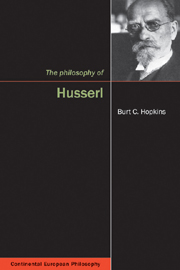Book contents
- Frontmatter
- Contents
- Acknowledgements
- Abbreviations
- Prolegomenon: Husserl's turn to history and pure phenomenology
- I Plato's and Aristotle's theory of eidē
- II From descriptive psychology to transcendentally pure phenomenology
- III From the phenomenology of transcendental consciousness to that of monadological intersubjectivity
- IV From monadological intersubjectivity to the historical a priori constitutive of all meaning
- 11 The pure phenomenological motivation of Husserl's turn to history
- 12 The essential connection between intentional history and actual history
- 13 The historicity of both the intelligibility of ideal meanings and the possibility of actual history
- 14 Desedimentation and the link between intentional history and the constitution of a historical tradition
- 15 Transcendental phenomenology as the only true explanation of objectivity and all meaningful problems in previous philosophy
- V The unwarranted historical presuppositions guiding the fundamental ontological and deconstructive criticisms of transcendental philosophy
- Epilogue: Transcendental-phenomenological criticism of the criticism of phenomenological cognition
- Coda: Phenomenological self-responsibility and the singularity of transcendental philosophy
- Notes
- Bibliography
- Index
14 - Desedimentation and the link between intentional history and the constitution of a historical tradition
from IV - From monadological intersubjectivity to the historical a priori constitutive of all meaning
- Frontmatter
- Contents
- Acknowledgements
- Abbreviations
- Prolegomenon: Husserl's turn to history and pure phenomenology
- I Plato's and Aristotle's theory of eidē
- II From descriptive psychology to transcendentally pure phenomenology
- III From the phenomenology of transcendental consciousness to that of monadological intersubjectivity
- IV From monadological intersubjectivity to the historical a priori constitutive of all meaning
- 11 The pure phenomenological motivation of Husserl's turn to history
- 12 The essential connection between intentional history and actual history
- 13 The historicity of both the intelligibility of ideal meanings and the possibility of actual history
- 14 Desedimentation and the link between intentional history and the constitution of a historical tradition
- 15 Transcendental phenomenology as the only true explanation of objectivity and all meaningful problems in previous philosophy
- V The unwarranted historical presuppositions guiding the fundamental ontological and deconstructive criticisms of transcendental philosophy
- Epilogue: Transcendental-phenomenological criticism of the criticism of phenomenological cognition
- Coda: Phenomenological self-responsibility and the singularity of transcendental philosophy
- Notes
- Bibliography
- Index
Summary
Maintaining the phenomenological integrity of knowledge requires enquiry into its original historical discovery
Husserl's phenomenological enquiry into the transcendental constitution of the origins of the ideal formations proper to mathematical and scientific objects reveals that the evidence of all the meaning formations belonging to a science such as geometry presupposes the link between intentional history and actual history. This link is established by Husserl on the basis of the following considerations. (i) The ideal intentional units at issue in these significant formations are the product (das Erwirkte) of an “accomplishment” that arises in their “anticipation” (Vorhabe) (OG, 367/356), not in their “retention”. (ii) The accomplishment of what is anticipated means evidence to the transcendental subject: herein the product shows itself originally as itself. (iii) Since the product, in the case of geometry, is an ideal product, “anticipation” and the corresponding “accomplishment”, as acts of the transcendental subject, are founded on the accomplishments of transcendental subjectivity. The ideal formations of geometry are products of the intentionality that is inseparable from this subjectivity. “Anticipation” and “accomplishment” translate into terms of actuality what properly takes place within the realm of transcendental subjectivity. (iv) The constitution of these ideal intentional units presupposes, of necessity, the whole complex of experiences leading to the situation in which geometry as a science is capable of being anticipated and intended. In other words, “Science, and in particular geometry, with this sense of being, must have had a historical beginning” (OG, 367), that is, a beginning within the course of actual history.
- Type
- Chapter
- Information
- The Philosophy of Husserl , pp. 192 - 203Publisher: Acumen PublishingPrint publication year: 2010



